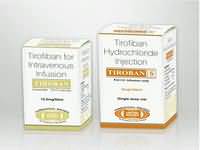neomycin sulphate

CLINICAL USE
Antibacterial agent:Bowel sterilisation before surgery Hepatic comaDOSE IN NORMAL RENAL FUNCTION
Bowel sterilisation: 1 g every hour for 4 hours, then 1 g every 4 hours for 2–3 daysHepatic coma: up to 4 g daily in divided doses usually for a maximum of 14 daysPHARMACOKINETICS
DOSE IN RENAL IMPAIRMENT
GFR (mL/MIN)
DOSE IN PATIENTS UNDERGOING RENAL REPLACEMENT THERAPIES
IMPORTANT DRUG INTERACTIONS
Potentially hazardous interactions with other drugsADMINISTRATION
Reconstition
–Route
Oral, topicalRate of Administration
–Comments
–OTHER INFORMATION
Only 3% of an oral dose is absorbed About 97% of an orally administered dose is excreted unchanged in the faeces. Impaired GI motility may increase absorption of the drug; therefore, possible that prolonged therapy could result in ototoxicity and nephrotoxicity, particularly in patients with a degree of renal failureIf renal impairment occurs the dose should be reduced or treatment discontinuedHigh doses associated with nephrotoxicity and ototoxicityIn mild renal failure, i.e. a GFR>50 mL/ min, the frequency should be reduced to every 6 hoursneomycin sulphate.
See how to identify renal failure stages according to GFR calculation
See how to diagnose irreversible renal disease
Home








